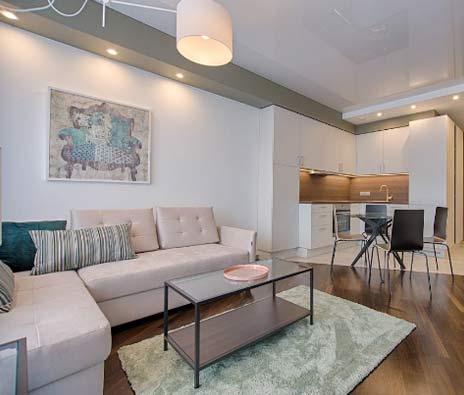Living in a small space can be both cozy and challenging. Whether it’s a studio apartment, a compact living room, or a tiny home office, limited square footage often feels restricting. But with the right design strategies, you can create the illusion of space without knocking down walls or spending a fortune.
A few clever adjustments to color, layout, and furniture can completely change how your home feels. Let’s explore practical ways to make any small room look bigger, brighter, and more comfortable.
Color and Light: Brighten to Expand
Color and lighting play a huge role in shaping how we perceive space. Lighter shades reflect more light and can make walls appear to recede, giving the illusion of a larger room. Whites, creams, and soft neutrals are timeless choices, while pale blues and greens add a calming effect. Natural light is your best ally, so avoid heavy curtains that block sunlight. Use sheer fabrics or light-filtering blinds to let in as much daylight as possible.
For a refined touch, consider designs from Blinds n Shutters, which can help you control brightness while maintaining an open, airy atmosphere. Strategic use of mirrors can also double the impact of your lighting. Placing a mirror opposite a window reflects light and scenery, making the room feel brighter and more spacious.
Keep Lighting Layers Flexible
Lighting can transform how a small room feels at different times of the day. Relying on a single overhead light often flattens the space and highlights shadows that make it appear smaller. Instead, mix multiple light sources such as table lamps, wall sconces, and floor lights to create depth and warmth.
Adjustable lighting lets you highlight certain corners or décor elements without overwhelming the room. Soft, warm lighting can make evenings feel cozy, while brighter, cooler light enhances daytime clarity. A layered lighting plan ensures your space stays functional, inviting, and visually balanced throughout the day.
Start With a Clean Slate
Before bringing in new décor or rearranging furniture, start by decluttering. A cluttered space can make even a large room feel cramped. Removing unnecessary items opens up visual space and creates breathing room for your furniture and design elements to shine.
Consider what you actually use or love, and let go of the rest. A tidy space immediately feels more open and organized. Once you’ve cleared the excess, cleaning surfaces and keeping things in order becomes much easier, and that alone can make a huge difference in how a space feels.
Choose the Right Furniture Scale
One of the most common mistakes in small spaces is using furniture that’s too large or bulky. Oversized sofas and heavy tables can dominate the room, making it feel smaller than it is. Instead, opt for pieces that fit the proportions of your space. Low-profile sofas, sleek coffee tables, and armless chairs can open up the view.

Furniture with visible legs helps create a sense of flow by allowing more floor area to show. Whenever possible, choose items that serve multiple purposes, such as storage ottomans, sofa beds, or foldable dining tables. A balance between functionality and size ensures comfort without sacrificing space.
Make Use of Vertical Space
When floor area is limited, think upward. Walls can do more than just hold pictures. Tall bookshelves, mounted cabinets, and floating shelves draw the eye up and emphasize height. Hanging plants or wall-mounted lighting fixtures also free up valuable floor space.
Even artwork can contribute to the illusion of height when placed slightly higher than eye level. This approach helps balance proportions, so the room doesn’t feel bottom-heavy. Using your walls wisely can transform a small area into one that feels well-organized and thoughtfully designed.
If you’re struggling with compact layouts, even in the kitchen, here’s how to design a small kitchen that looks bigger using color, lighting, and smart cabinetry ideas.
Create Visual Flow
Visual continuity is key in a small room. Avoid abrupt color or pattern changes that break up the space. Instead, use similar tones throughout to create a smooth flow from one area to another. Rugs and flooring that extend across different zones without interruption can make the room appear larger.
If your layout combines living, dining, and work areas, use consistent design elements like matching finishes or complementary materials to connect them. When the eye moves smoothly around the room, the entire space feels cohesive and open.
Pay Attention to Textures and Materials
Heavy materials and dark fabrics tend to absorb light and make a space feel dense. Choose lighter materials such as linen, cotton, or glass to keep things visually soft. Transparent furniture pieces, like acrylic tables or glass shelving, almost disappear into the background and make a room feel less crowded.
Reflective surfaces like metal or glossy finishes can also add dimension. A thoughtful mix of textures—smooth, rough, shiny, and matte—adds interest without overwhelming the senses. It’s all about maintaining balance and openness while keeping your style intact.
Add Personality Without Overcrowding
Even when space is limited, personality should never be. The goal isn’t to strip your home of character but to showcase it thoughtfully. A few statement pieces can say more than a room filled with many small items.
A bold artwork, a patterned throw, or a single accent chair can draw attention without creating clutter. Be intentional with your décor choices and give every object a purpose or story. Minimal doesn’t have to mean sterile; it simply means your favorite things get the spotlight they deserve.
Conclusion
Transforming a small space into a stylish and comfortable home doesn’t require major renovations. With smart use of color, light, furniture, and layout, you can create a room that feels airy and inviting. The key lies in thoughtful design decisions that maximize what you already have. When every piece serves a purpose and contributes to openness, even the smallest space can feel surprisingly spacious and beautifully balanced.






